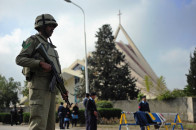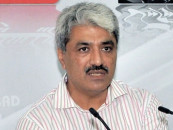For drug control: Capacity building, information sharing are paramount
New report cites problems after devolution for complicating situation.

The INCB 2012 report pointed out that Pakistan and neighbouring Iran have some of the highest annual legitimate requirements or quotas for ephedrine. PHOTO: AFP
The federal government needs to focus on capacity building and sharing information with provincial governments to effectively address drug control.
This was part of an annual report for 2012 released by the International Narcotics Control Board (INCB) on Tuesday.
The INCB is an independent, quasi-judicial body that tracks the compliance of member states with United Nations drug control conventions.
The INCB report mentioned challenges posed to Pakistan’s implementation of UN drug control conventions in the post-18th Amendment scenario.
The report noted that the government of Pakistan has made advances in supply reduction and improving coordination between law enforcement agencies combating drug trafficking, but it also stated that “the devolution of responsibilities from federal to provincial level foreseen under the Eighteenth Amendment to the Constitution in 2010 has yet to materialise.”
“Pakistan is a signatory to a lot of international drug control conventions,” said Jeremy Douglas, country representative of the United Nations Office of Drug Control (UNODC) in Pakistan. “If you devolve power without necessarily telling the provincial governments what they are responsible for, you have problems.”

For now, the Ministry of Narcotics Control issues quotas for drugs that are used to manufacture medicines, and the Anti Narcotics Force then checks on whether or not the quota is being spent properly. But once the medicines are disbursed, they can still be used to make illegal drugs or used by drug abusers, and that is where the provincial health ministries have a role to play.
In September 2012, the INCB sent a country mission to Pakistan consisting of a board member and a staff member. Here, the mission met with different ministries and agencies involved in drug regulation and monitoring.
The mission’s visit coincided with ongoing investigations in the ephedrine scandal in which around nine tons of the drug was issued to some pharmaceutical companies, and allegedly diverted away from those companies.
The report made a subtle reference to the ephedrine scandal by stating that the lack of a monitoring mechanism for precursor chemicals in Pakistan has increased the risk of these chemicals being diverted to manufacture illegal drugs.
A drug precursor is a chemical used to make illicit drugs. Ephedrine, which is used in cold and asthma medicines, can be used to make methamphetamine or “meth” — a highly addictive stimulant drug.
The INCB 2012 report also pointed out that Pakistan and neighbouring Iran have some of the highest annual legitimate requirements — or quotas — for ephedrine. Incidentally, in the past few years, Iran has become one of the top producers of meth.
In fact, the report mentions that Iran reported “several significant seizures” of ephedrine in 2011, some of which originated in Pakistan.
Douglas said one of the underlying concerns echoed in the report is the “need to strengthen the regulatory framework because a lot (of drug precursors) could be slipping through the cracks.”
“The ideal scenario would be to strengthen the capacity of the Ministry of Narcotics Control,” Douglas said. “It would help if they can assess the need for a legitimate drug and then generate quotas based on that need.” This way the field checks of the companies who are allocated the legitimate drugs could be improved to ensure if the quota is being used properly, he said.
According to the INCB report, Pakistan is affected more by cross-border trafficking — which has a local value of between $910 million and $1.2 billion — than local cultivation and production.
The INCB includes Pakistan in the West Asia region and it stated that the demand for illicit stimulants, such as cocaine and methamphetamine, appears to be increasing in parts of West Asia.
The synthetic drug issue has opened up a new, albeit small, front for Pakistani law enforcement already tied up with stopping the trafficking of heroin and opium originating from Afghanistan.
According to the 2009 UNODC report on “Crime, Addiction and Insurgency” in Afghanistan, around 40 per cent — or 150 tonnes — of Afghanistan’s heroin is trafficked through Pakistan, while 30 per cent of its opium — or around 1,000 tonnes — passes through Pakistan from Afghanistan each year.
Published in The Express Tribune, March 6th, 2013.



















COMMENTS
Comments are moderated and generally will be posted if they are on-topic and not abusive.
For more information, please see our Comments FAQ